Updated: 19-May-2020
The Armstrong Siddeley used to give their piston engines feline names. curiously, in their different Logos they show a 'sphinx" with feline body.

"Logos Armstrong-Siddeley"
-Beginning with the name "Puma", when this company was known as Siddeley-Deasy before merging with Armstrong Whitworth in 1920 (the latter mainly built aircraft).
-Perhaps the brand's most famous piston engine was the "Cheetah" because of its mass production and many applications.
-The gas turbines, however, had reptile names.
-Siddeley and Armstrong were part of the AVRO group so that these engines sometimes appear with a name like Avro "Lynx".
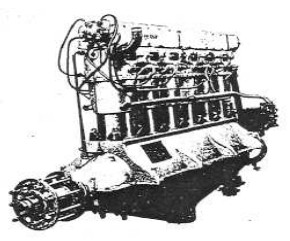
"Armstrong-Siddeley Puma"
-The liquid-cooled "Puma" from 1917 gave 240 hp and was one of the first aluminum engines and that had removable valve seats.
-The Puma was an upright 6-cylinder engine with an overhead camshaft, directly controlling the intake and exhaust valves via a rocker. They were mounted on the DH-9 and other aircraft.
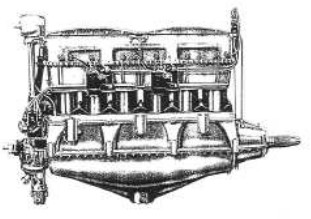
"Armstrong-Siddeley Puma"
-An advertisement from 1920 of Armstrong Siddeley Motors Limited in Coventry offering a six-cylinder engine (Puma or derivative).

"Armstrong-Siddeley advertisement"
-Following a chronological order, in 1918 the "Jaguar" came out, which was an air-cooled, 14-cylinder double star engine with seven cylinders in each row. It had 25 liter displacement and gave 400 hp at 1,700 rpm. Although it started with 300 hp, it evolved to reach 425 hp with gearbox.

"Armstrong-Siddeley Jaguar"
-A rare photograph of the "Jaguar" is the side view below where we can see the two cylinder rows.
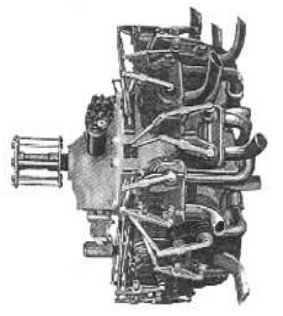
"Armstrong-Siddeley Jaguar, lateral"
-In 1920, Siddeley built the V12 with two rows of "Puma" cylinders in V but with little commercial outlet.
-Also in 1920 and to access a ministerial competition destined to ultralight vehicles, they manufactured the "Ounce" that gave 45 hp at 1600 rpm and 50 hp at 1,800 rpm. It had double ignition.

"Armstrong Siddeley Ounce"
-Next was the "Lynx", which appeared in 1920. It was a 7-cylinder, radial engine, actually half a "Jaguar". This engine has been built for 19 years and it delivered around 200 hp.

"Armstrong Siddeley Lynx"
-Regarding the Lynx engines, now we can show a model with gearbox and a IV-C with the exhaust manifold ring.

"Armstrong Siddeley Lynx with gear"
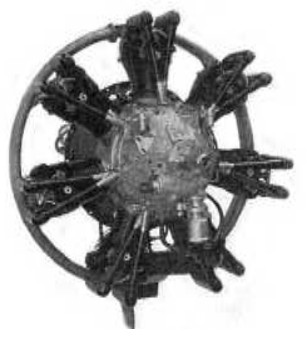
"Lynx with exhaust ring"
-By 1925 the "Genet" came out, a 5-cylinder engine and the "Genet Major" with 7 cylinders in 1928.
-We also have two more photographs of Genet and the Genet Major, which were made with 5 and 7 cylinders.
-The normal Genet has 5 cylinders in such a way that there is one located at 12 o'clock.
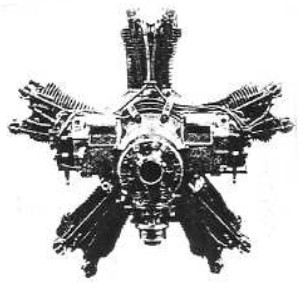
"Genet-Major with 5 cylinders"
-The first one with 4.1 l delivered 80 hp and had the electric accessories and magnetos on the front side, near the propeller drive, while the fuel and oil pump as well as the carburetor were at the rear.

"Another Genet, rear view"
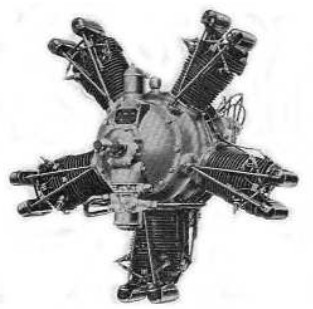
"Genet-Major with 5 cylinders"
-The Genet-Major with five cylinders was from 1929. It had one bottom cylinder, which is not common for in most engines normally there is a small oil sump in that place.

"Genet-Major with seven cylinders"
-The Genet-Major with five cylinders gave 100 hp at 2,200 rpm.
-The Genet-Major with seven cylinders delivered 150 hp at the same rpm.
-The Mongoose also has this cylinder at 6 o'clock.
-The Cougar was also from this time and was considered to be of medium power. It had the following powers with 9 cylinders:
-Max. cruising with rich mixture, 560 hp at 2,300 rpm.
-Max. cruising with poor mixture, 450 hp at 2,300 rpm.
-Max. in ascending conditions, 660 hp at 2,500 rpm.
-Max. in leveled conditions, 690 hp at 2,700 rpm.
-Max. takeoff condition as at sea level, 850 hp at 2,800 rpm.
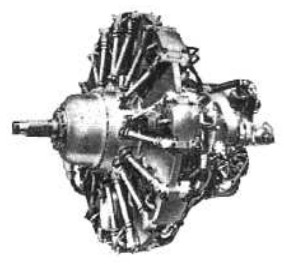
"Armstrong Siddeley Cougar"
-Next the “Mongoose” from 1926. With “Jaguar” cylinders and 130/150 hp.
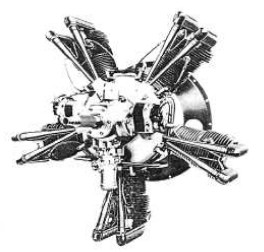
"Armstrong Siddeley Mongoose"
-The “Mongoose” is considered the 5-cylinder version of the “Lynx” that had 7 cylinders. It was aimed to the lightweight market, but there was little demand.

"Armstrong Siddeley Civet"
-In 1927, the "Civet" was developed from the "Genet Major" and it gave 140 hp. It was installed in the Cierva C30A.
-By 1928, there was a double "Mongoose" version called "Serval" with approximately 18 liters of displacement and ten cylinders in two rows.
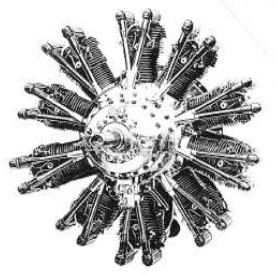
"Armstrong Siddeley Serval"
-It had reduction gear and gave 340 hp at 2000 rpm.
-The “Leopard” is from these years too.
-When they introduced the "Leopard" it was one of the most powerful engines of its time, giving 700 hp.
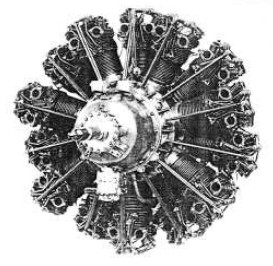
"Armstrong Siddeley Leopard"
-Initially it was planned to have four valves in the cylinder head but it ended up with two. It was a fourteen-cylinder, two-row radial engine with 48.5 lts. of displacement.
-In 1929 the "Panther" came out. This engine was installed in the HE46F and the Fairey Gordon II.
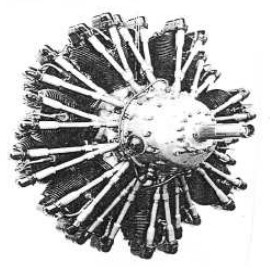
Armstrong Siddeley Panther
-At first, "Panther" was the name given to "Jaguar Major" that was introduced in 1930 and later became known as "Tiger".
-The "Tiger VIII" version is shown below with two-speed supercharger and delivering 920 hp at takeoff.

"Armstrong Siddeley Tiger VIII"
-The Tiger VIII below has 14 cylinders and at takeoff it delivers 1,300 hp at 2,800 rpm with gearbox.

"Armstrong Siddeley Tiger VIII"
-1929 also was the year in which the "Major Lynx" has been developed.
-Here we come to the most prolific and well-known ASM engine, the "Cheetah", a very successful engine from which they developed numerous models with various powers.

"Armstrong Siddeley Cheetah X"
-With 7 cylinders it obtained 385 hp (in the XVII, XVIII, 25, 26, 27 series) or 420 hp in the XI, XV series. Generally without gear, although the 420 series did have it.
-Others had superchargers. More than 37,000 “Cheetahs” were built.

"Armstrong Siddeley Cheetah 420/425 hp"
-This 420/425 hp series together with the XV maybe were the larger ones.
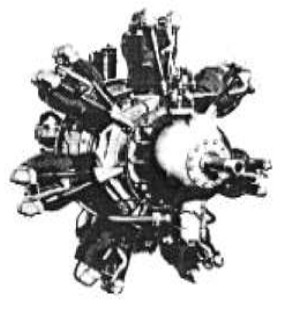
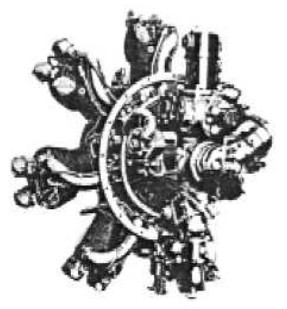
“Cheetah XV, two views”
-A mysterious 14-cylinder engine, large and powerful, was the “Mastiff”, of which we do not have more information.
-After the classic engines era, ASM began with obtaining greater power with less orthodox radial engines with original shapes.
-In 1932 the “Hyena”, the “Deerhound”, “Boardhound” and “Wolfhound” appeared.

"Armstrong Siddeley Hyena"
-As we can see with the names, to differentiate, these engines they passed to give them canine names.
-The "Hyena" had three rows of five cylinders aligned one behind another, that means, not interspersed, which was commonly used for good cooling.
-It had a total of 15 cylinders, gear and moderated supercharging.
-There were camshafts between each row of three cylinders and it had short push rods. It gave 650 hp at 2250 rpm.

"Armstrong Siddeley Deerhound"
-The "Deerhound" was similar but with 21 cylinders in three rows of seven cylinders giving 1500 hp.
-The design was a "Hyena" variant and the principal difference was that the camshafts were on top of the cylinder heads (today we call this OHC) and that the cylinder cooling was done from back to front. This needed a constant redesign of hoods and deflectors to rule out punctual overheating.
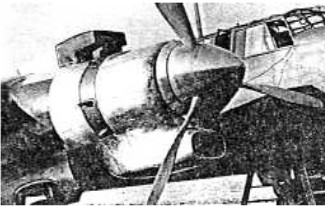
"Deerhound Power-Egg"
-As they could not solve the latter, the project was eventually shelved. Together with this engine they prepared a larger one, the "Wolfhound" with 28 cylinders in 4 rows of seven cylinders, but here too, the cooling was source of problems.
-The "Boardhound" was an even greater postwar design (1937), with 27 cylinders in three rows of nine cylinders and did not progress either. It gave around 2300 hp at 2700 rpm.
-With these engines they completed the new ASM piston-engines projects.

"Armstrong Siddeley ASX"
-In 1940, they began to work on gas turbines. First they applied Griffith's ideas on reverse flow turbojets with 14 stages, which gave rise to the turbojet ASX in 1943.
-It had eleven separate combustion chambers and a two stage turbine. It gave 2,600 lbs. of thrust at 8,000 rpm.
-The next engine was the ASP, from 1945, which actually was the ASX with propeller drive. It gave 3,600 SHP 1,100 lbs. thrust.
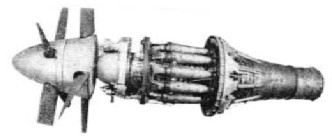
"Armstrong Siddeley Python"
-The ASP immediately gave rise to the "Python" (as stated earlier, turbines have reptile names). These engines were mounted on the Wyvern.
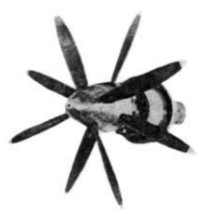
"Armstrong Siddeley Python"
-It is only too well known that the propellers are double and contra-rotating.
-By 1945 they also started to develop the "Mamba". It was the first turbine that used vaporizers instead of injectors, which had a notably heat efficiency.
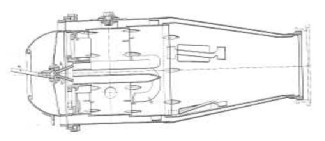
"AS combustion chamber"
-This type of vaporizers we see in other engines like the "Viper" of the same company. The fuel comes from the front and through small ducts that end up in angled larger tubes to make the fuel and air mix and vaporize, once the engine is running and warm, leaving at cross-current and burning perfectly.
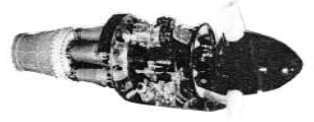
"Armstromg Siddeley Mamba"
-They were turboprops of 1,000 hp. The first "Mambas" had separate combustion chambers. In later versions they switched to a single annular chamber.
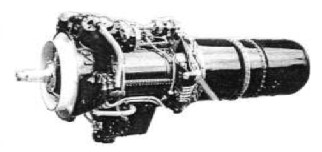
"Armstrong Siddeley Mamba"

"Armstrong Siddeley Mamba"
-Legend:
-A, oil manifold and high pressure valve.
-B, main pressure-oil filter.
-C, normal and high pressure pump.
-D, tachometer.
-E, air-cooling duct for rear bearings.
-F, fuel filter-control.
-G, starter.
-H, air-cooling duct for front bearings..
-I, micropump for rear bearings.
-As a pair development with this engine they made the "Double Mamba", first with separated combustion chambers and later with annular chambers.
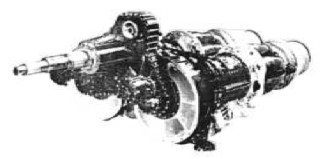
"Double Mamba with separated combustion chambers"
-These engines had a stunning gearbox that coupled both independent engines and besides the propellers were coaxial and contra-rotating.
-This formula made it possible to stop one engine and save fuel to reduce consumption, especially in patrol aircraft.
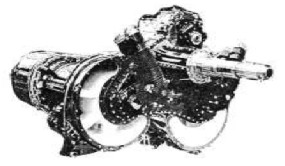
"Double Mamba with annular combustion"
-Their use was strictly military and for not depending on ground equipment when starting these engines (England was still very distant "spades") they used Coffman cartridge engine starters. When these engines started we saw a nearly vertical black smoke stream above the airplane.
-In the illustration above the two cartridges are -double- for each engine on top of the gearbox. Vane turbines took the expanded gas energy to rotate each motor independently.

"Double Mamba version on wing"
-A simple "Mamba" version was the "Adder". Removing propeller and gearbox it was used as a pure turbojet. Afterburner tests were also made.

"Armstrong Siddeley Adder"
-It had ten axial compressor stages and a two-stage turbine. (Stage = one stator and one rotor).
In 1950, the interesting "Viper" came out. First they were used as expendable or disposable short life engines for target and decoy air vehicles like the Australian Jindivik target drone.
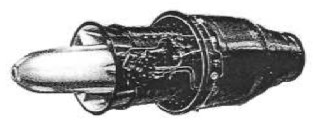
"Armstrong-Siddeley Viper S-L"
-It has 7 axial compressor stages, injection vaporizers, annular combustion chamber and single turbine. The thrust was around 1,650 lbs.
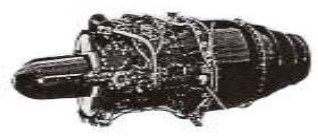
"Armstrong-Siddeley Viper L-L"
-And the differences between the expendable ASV 3 engine (the Australian missile Jindivik) and its subsequent derivative, Viper, are shown below.
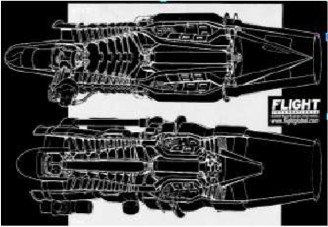
"Cutaway from the Flight magazine” (PiP)
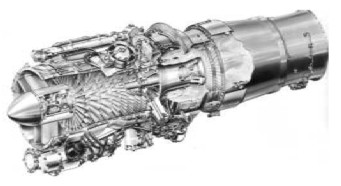
"Armstrong-Siddeley Viper, 600 series"
-The most advanced Viper series were already developed by Bristol or Rolls-Royce. The most striking feature was that there was not any system for collecting oil from the rear bearing, so the oil went outside and was lost. This was replaced in Long-Life versions and with the right materials.
-The engine oil has to be added with one can of 1 Qt. for every hour of flight approximately. Another detail of their quality it is that the engine TBO (time between overhauls) is 5,000 hours instead of 3,500 hrs. of the same sort of engines (1980-90).
-These engines were built in France by Marcel Dassault as the MD-30 model.
-The "Viper", so old, remained in production through the vicissitudes of different companies: in 1959 Armstrong Siddeley goes to Bristol Engines to form Bristol-Siddeley and now both belong to the Rolls-Royce group.
-They have manufactured more than 6,000 Viper engines and its development went from 1,650 lbs. of thrust when they began production to almost 5,000 lbs. for the latest model.
-It became prohibited for civil aviation when anti-noise and anti-pollution regulations appeared. Except the military versions, of course.
-In 1947 another important engine was introduced in ASM's production line, the "Sapphire", just when Metropolitan Vickers' ceased its aero engine production and therewith the production of this engine.
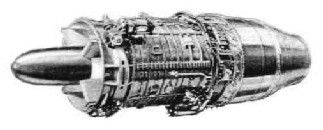
"Armstrong-Siddeley Sapphire"
-The "Sapphire" has 13 compressor stages, 36 fuel vaporizers in an annular combustion chamber and a two stage turbine, simple but delivering 7,550 lbs. of thrust that evolved over time up to 11,000 lbs and to 13,400 lbs. with a simple afterburner.
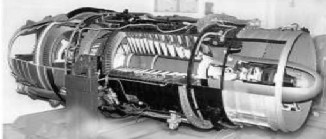
"Sapphire 200, cutaway"
-In the USA it was built by Wright as the J-65.
-ASM made a last project that was the P-181 1,000 SHP helicopter turboshaft to evolve upto 2,000 SHP.

"Armstrong Siddeley P-181"
-And the 1,100 hp turboprop version with the P-181 core.

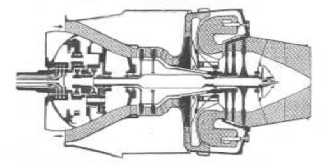
"Armstrong Siddeley P-182"
-It has double shaft and the HP comprises the centrifugal compressor and a turbine. The LP shaft moves through the second turbine and involves two axial compressor stages. Towards the front is the gearbox and the propeller. The combustion chamber is reverse flow.
-Since 1946, they also worked in parallel on support engines through liquid rockets.
-One of the first rocket engines was the PR-23 showed below.

"Armstrong Siddeley PR-23"
-But the two best known rocket engines were the "Snarler" and "Screamer".
-The first one ran on liquid oxygen and alcohol, feeding a separate chamber by pumps. The nominative thrust was 2,000 lbs.
-It was used to power an interceptor aircraft at high altitudes such as the Hawker Sea Hawk.

"Armstrong Siddeley Snarler"
-In the cabin there were two switches, one for starting and stopping and another for total or partial thrust.
-More powerful (8,000 lbs) was the “Screamer”, destined for the Avro 720.
-Under the engine we can see two exhausts of the turbo-pumps, which are using the same fuel, and a gas generator for these pumps.

"Armstrong Siddeley Screamer"
-It is considered that the ramjet Thor, which appears in the Bristol and Rolls-Royce chapters, began its journey in Armstrong Siddeley as we can see in the picture below.
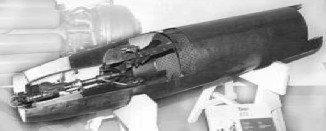
"The Thor -BT2-, at the Luftwaffe museum"
-Finally and barely known, nor was it a proposal for ASM, there is the "Tri-Viper" project of the French engineer P. Valroger in 1957. It is an installation of three Viper engines in the same way as revolver bullets around the propeller shaft.

"Armstrong Siddeley Tri-Viper"
-The exhaust gas jets from the three engines are led to a large diameter turbine that uses its kinetic energy to drive the gear and therewith the propeller. In some way, if it was a single engine, it would be the old formula of the General Electric turbofan.
-From the appendices 1, 2, 6 and 7: From Rolls Royce Heritage Trust we obtained a picture of the Armstrong Siddeley ASX turbojet.

"Armstrong Siddeley ASX model" (PiP)
-Using the front drive of the main shaft, they created the ASP turboprop which gave way to the Python.
-Similarly, but the other way around, from the turboprop Mamba 2 they made the Adder turbojet or ASA.1.
-We have a new picture of this engine, made by Philip Jarrett. Also new are the Double Viper and Mamba pictures.
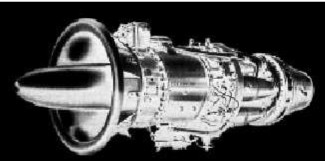
"Armstrong Siddeley Adder" (PiP)
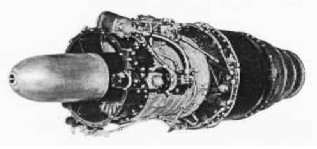
"Armstrong Siddeley Viper" (PiP)
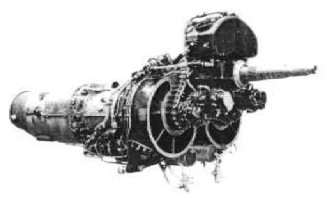
"Armstrong Siddeley Double Mamba" (PiP)
-In this Double Mamba we cannot see the starter cartridges as shown in the main text. In their place there are two electric starters, one in front of each engine.
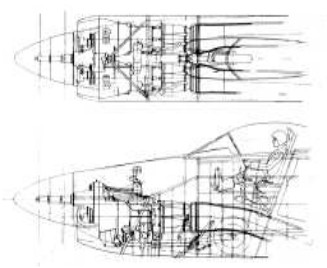
"Convair XP-81 aircraft with a proposal for Double Mamba"
-The Mongoose 5-cylinder engine gave rise to the 10-cylinder Double Mongoose. (later the double one would be named Serval).
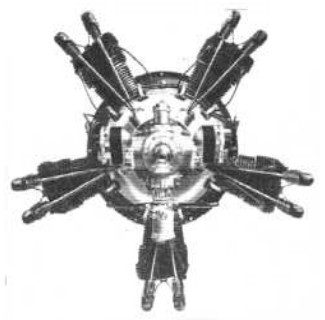
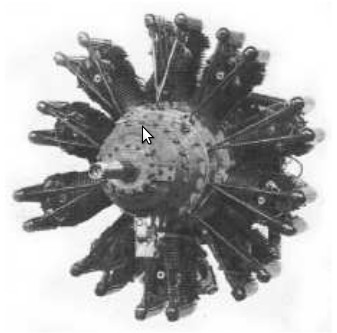
“The Mongoose and the Double Mongoose”
-The magnetos that are in the front of the 5-cylinder engine have passed to the rear of the Double together with the other accessories.
-In the 5-cylinder engine emphasizes always the lower cylinder, situated on a place that in most radial engines is normally occupied by a small sump.
-The P-181 and P-182 turbines, mentioned in the main text, now appear in other variants that do not have the same appearance, at least at first glance.

"Armstrong Siddeley P.181 turboshaft"
-This P-181 turboshaft bears little resemblance to the version of the main text. The air intake is produced near the engine's rear with the gas flowing forward leaving through two side outlets. It delivered 1,000 HPS.

"Armstrong Siddeley P.182 turboprop"
-The P-182 is designed more genuinely as turboprop, with reverse circulation (see PT-6 P & W Canada and the Walter M-601).
-In Wiki Commons (free) has appeared this stunning AS Python photograph. It has double, contra-rotating propellers and together with a workingman under the engine it looks rather impressive.
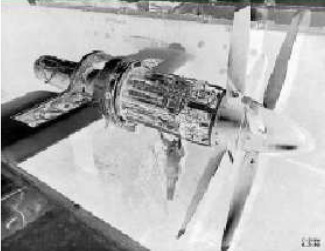
"AS Python"
-Some curious photographs of engine installations and their exhaust ducts.
-Rarely we see the Armstrong-Siddeley triple-engine system used in a transport plane like in the picture below.

"With three A-S Jaguar IV-A"
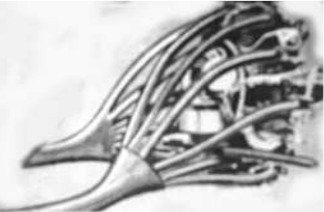
"Another example of that time"
From Appendix 10: We have more information on certain high power piston engines that were made by the brand before entering turbine manufacturing. By studying engineer Stewart S. Tresilian's biography. Tresilian appears as chief designer for engines that today we would call "polygonal".
-There are also some differences to which is described in the main text -small, but there are-. We start with the "Hyena", of which two versions were made. The first one is the one that has a more rounded engine cowling.
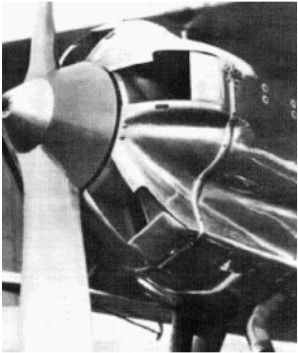
“The other version of the engine cowling”
-We note that there some splits that match the five blocks of three cylinders. The cooling air intakes are larger in the part of the movable hatches.
-The 15 cylinders gave 620/650 hp of power in both versions
-In 1935 they made the "Terrier" engine (new in this publication), a 14-cylinder with two rows of 7 cylinders each. It gave 550 hp and had a mechanical two-speed supercharger. Only 5 engines were made, and we haven't any illustration yet.
-Another engine that is not described above was the "Whippet", which also was a 14-cylinder with two rows of seven cylinders each. This engine gave 250 hp.
-Now we into large piston engines that reached the limit before they started to build turbines. The most interesting engine is the "Deerhound" of which four versions were made.

"Deerhound I"
-All "Deerhounds" had 21 cylinders in three rows of seven cylinders. The main feature was that the three rows were aligned cylinder to cylinder, so they could use a common cam shaft.
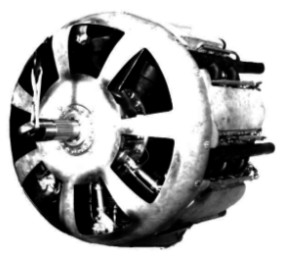
"Deerhound I, faired"
-The "Deerhound II" was similar in architecture, and it delivered around 1,500 hp.
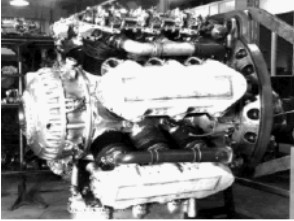
"Deerhound II"
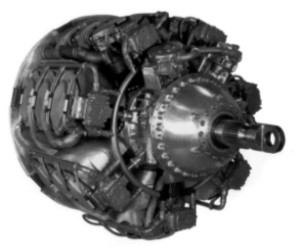
"Deerhound III"
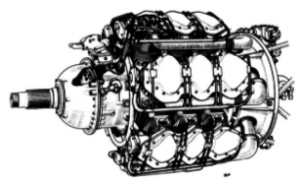
"Deerhound IV, was not built, it remained as a project"
-There is contradicted information regarding the "Wolfhound". Initially we had the 24-cylinder version with 4 rows of 6 cylinders that gave 2,800 hp. Subsequently we have another version of 28 cylinders with 4 rows of 7 cylinders and the same power.
-The same thing happens with the "Mastiff". Perhaps because there also were two versions (I and II). From the first one, the 14-cylinder with two rows of seven cylinders only one engine was made. The other version had four rows of nine cylinders with a total power output of 36 4,000/5,000 hp.
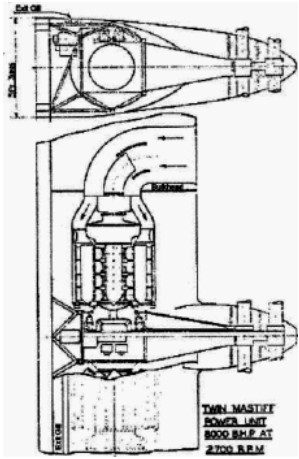
"Mastiff installation project"
-The "Mastiff" which was from 1932, has not been manufactured, just as the "Boardhound" from 1937.
-The latter had 4 rows of 7 cylinders with a total of 28 cylinders and delivered 2,300 hp.
This company started the studies, manufacture and testing of BT-1 and BT-2 ramjets known as "Thor" (also "Odin", etc.).
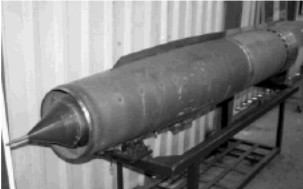
"The Thor ramjet"
-We found a photo of a complete engine and another one, a cutaway that, for its interest we move to this part of Engines A-Z
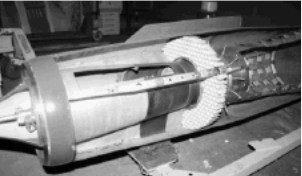
"Front of engine"
-In this photo we can see the inlet cone, the convergent-divergent intake, the flame holder and in the rear there is the burner.
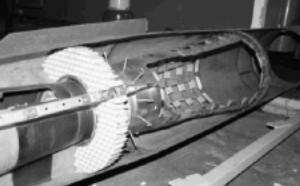
"Rear of the same engine"
-In the second image we see the burner in more detail with the successive air intakes that helps to center the flame and protects the lining material of the chamber.
-These engines were installed on the" Bloodhound "ground-to-air missiles, attached to the main body.
-Formidable photo of a faired Armstrong-Siddeley "Ounce". Together with a generator with a propeller fan.

"A good AS Ounce installation"
Engines of ARMSTRONG SIDDELEY
Model: Adder
Arquitecture: Turbojet
Compressor/s: 10 stage axial flow
Combustion chambers: Six-can
Turbines: 2-stage axial
Power / Thrust: --- / 1050 Lbf
Weight:
A simple "Mamba" version was the "Adder". Removing propeller and gearbox it was used as a pure turbojet. Afterburner tests were also made.

"Armstrong Siddeley Adder"
Model: ASP
Arquitecture: Turboprop
Compressor/s:
Combustion chambers:
Turbines:
Power / Thrust: 3600SHP / 1100 Lbf
Weight:
The ASP, from 1945, actually was the ASX with propeller drive.
Model: ASX
Arquitecture: Turbojet
Compressor/s:
Combustion chambers: 11 separated chambers
Turbines: 1 two-stage
Power / Thrust: --- / 2600 Lbf
Weight:
In 1940, they began to work on gas turbines. First they applied Griffith's ideas on reverse flow turbojets with 14 stages, which gave rise to the turbojet ASX in 1943.

"Armstrong Siddeley ASX"
Model: Boarhound
Arquitecture: 27-cylinder Radial
Cooling:
Total Displacement:
Bore / Stroke:
Power: 2300 HP @ 2700 rpm
Weight:
The "Boardhound" was an even greater postwar design (1937), with 27 cylinders in three rows of nine cylinders and did not progress.
Model: BT-1 / BT-2
Arquitecture: Ramjet
Chambers:
Fuels:
Feed System:
Ignition:
Thrust:
Weight:
Model: Cheetah
Arquitecture: 7-cylinder Radial
Cooling: Air
Total Displacement: 834 cu. in.
Bore / Stroke:
Power: 270 / 420 HP @ 2425 rpm
Weight:
The most prolific and well-known ASM engine, the "Cheetah", was a very successful engine from which they developed numerous models with various powers.
With 7 cylinders it obtained 385 hp (in the XVII, XVIII, 25, 26, 27 series) or 420 hp in the XI, XV series. Generally without gear, although the 420 series did have it.
Others had superchargers. More than 37,000 “Cheetahs” were built.
This 420/425 hp series together with the XV maybe were the larger ones.

"Armstrong Siddeley Cheetah 420/425 hp"
Model: Civet
Arquitecture: 7-cylinder Radial
Cooling: Air
Total Displacement: 452 cu. in.
Bore / Stroke: 4.25 x 4.5 inch
Power: 140 HP @ 2400 rpm
Weight:
In 1927, the "Civet" was developed from the "Genet Major". It was installed in the Cierva C30A.

"Armstrong Siddeley Civet"
Model: Cougar
Arquitecture: 9-cylinder Radial
Cooling: Air
Total Displacement: 1176 cu. in.
Bore / Stroke:
Power: 850 HP @ 2800 rpm
Weight:
The Cougar, considerated to be of medium power, had the following powers with 9 cylinders.
-Max. cruising with rich mixture, 560 hp a 2300 rpm.
-Max. cruising with poor mixture, 450 hp a 2300 rpm.
-Max. in ascending conditions, 660 hp a 2500 rpm.
-Max. in leveled conditions , 690 hp a 2700 rpm.
-Max. takeoff conditionas at sea level, 850 hp a 2800 rpm.

"Armstrong Siddeley Cougar"
Model: Deerhound
Arquitecture: 21-cylinder Radial
Cooling: Air
Total Displacement:
Bore / Stroke:
Power: 1500 HP @ rpm
Weight:
The "Deerhound" was similar to the "Hyena" but with 21 cylinders in three aligned rows of seven cylinders.

"Armstrong Siddeley Deerhound"
Model: Genet
Arquitecture: 5-cylinder Radial
Cooling: Air
Total Displacement:
Bore / Stroke: 4 x 4 inch
Power: 80 HP @ 2200 rpm
Weight: 168 Lb
By 1925 the Genet came out. The Genet had the electric accessories and magnetos at the front side, near the propeller drive, while the fuel and oil pump as well as the carburetor were at the rear.

"Armstrong Siddeley Genet rear view"
Model: Genet-Major (5-cyl)
Arquitecture: 5-cylinder Radial
Cooling: Air
Total Displacement:
Bore / Stroke:
Power: 100 HP @ 2200 rpm
Weight:
The Genet Major radial engines, were made with 5 and 7 cylinders.
The Genet-Major with five cylinders was from 1929. It had one bottom cylinder, which is not common, for in most engines normally there is a small oil sump at that site.
El Genet-Major with seven cylinders delivered 150 hp at the same rpm.

"Genet-Major 5 cylinders"
Model: Genet-Major (7-cyl.)
Arquitecture: 7-cylinder Radial
Cooling: Air
Total Displacement:
Bore / Stroke:
Power: 150 HP @ 2200 rpm
Weight:
The Genet Major radial engines, were made with 5 and 7 cylinders.
Model: Hyena
Arquitecture: 15-cylinder Radial
Cooling: Air
Total Displacement:
Bore / Stroke:
Power: 650 HP @ 2250 rpm
Weight:
The "Hyena" had three in-line rows of five cylinders, that means, not interspersed, which was commonly used for good cooling.
It had reducing gear and moderated supercharging.
There were camshafts between each row of three cylinders and it had short push rods.

"Armstrong Siddeley Hyena"
Model: Jaguar
Arquitecture: 14-cylinder Radial
Cooling: Air
Total Displacement: 25 Ltr.
Bore / Stroke:
Power: 400 HP @ 1700 rpm
Weight:
In 1918 the "Jaguar" came out, a 14-cylinder double row engine with seven cylinders in each row. Although the began with 300 hp, it evolved to reach 425 hp with gearbox.

"Armstrong-Siddeley Jaguar"
Model: Leopard
Arquitecture: 14-cylinder Radial
Cooling: Air
Total Displacement: 2970 cu. in.
Bore / Stroke: 6.0 x 7.5 inch
Power: 700 HP @ 1650 rpm
Weight:
When they introduced the "Leopard" it was one of the most powerful engines of its time.
Initially it was planned to have four valves on the cylinder head but it ended up with two. It had two rows of seven cylinders.

"Armstrong Siddeley Leopard"
Model: Lynx
Arquitecture: 7-cylinder Radial
Cooling: Air
Total Displacement:
Bore / Stroke: 5.0 x 5.5 inch
Power: 187 HP @ 1700 rpm
Weight: 525 Lb
The "Lynx" appeared in 1920.

"Armstrong-Siddeley Lynx with gear"
Model: Mamba
Arquitecture: Turboprop
Compressor/s: 10 stage axial flow
Combustion chambers: 6 combustion chambers
Turbines: 2-stage
Power / Thrust: 1320SHP / 405 Lbf
Weight:
By 1945 they also started to develop the "Mamba". It was the first turbine that used vaporizers instead of injectors.
The first "Mambas" had separate combustion chambers. In later versions they switched over to a single annular chamber.

"Armstrong Siddeley Mamba"
Model: Mastiff
Arquitecture: 14-cylinder Radial
Cooling:
Total Displacement:
Bore / Stroke:
Power: @ rpm
Weight:
A mysterious 14-cylinder engine, large and powerful, was the “Mastiff”, of which we do not have more information.
Model: Mongoose
Arquitecture: 5-cylinder Radial
Cooling: Air
Total Displacement: 540 cu. in.
Bore / Stroke: 5 x 5.5 inch
Power: 130 / 150 HP @ 1750 rpm
Weight: 340 Lb
The “Mongoose” was from 1926. It had Jaguar cylinders.
The “Mongoose” is considered the 5-cylinder version of the “Lynx” that had 7 cylinders. It was aimed to the lightweight market, but there was little demand.

"Armstrong Siddeley Mongoose"
Model: Ounce
Arquitecture: 2-cylinder Horizontally opposed
Cooling: Air
Total Displacement: 196 cu. in.
Bore / Stroke: 5 x 5 inch
Power: 45 HP @ 1600 rpm
Weight:
It could reach 50 hp at 1800 rpm. It had double ignition.

"Armstrong-Siddeley Ounce"
Model: P-181
Arquitecture: Turboshaft
Compressor/s:
Combustion chambers:
Turbines:
Power / Thrust: 1000SHP / ---
Weight:
ASM made a last project that was the P-181 1,000 SHP helicopter turboshaft to evolve upto 2,000 SHP.

"Armstrong Siddeley P-181"
Model: P-182
Arquitecture: Turboprop
Compressor/s:
Combustion chambers:
Turbines:
Power / Thrust: 1100SHP / ---
Weight:
The 1100 hp turboprop version with the P-181 core.

"Armstrong Siddeley P-182"
Model: Panther
Arquitecture: 14-cylinder Radial
Cooling: Air
Total Displacement: 1667 cu. in.
Bore / Stroke: 5.25 x 5.5 inch
Power: 638 HP @ 2400 rpm
Weight:
In 1929 the "Panther" came out. This engine flew on the HE46F and the Fairey Gordon II.

"Armstrong Siddeley Panther"
Model: PR-23
Arquitecture: Rocket engine
Chambers:
Fuels:
Feed System:
Ignition:
Thrust:
Weight:
Since 1946, they also worked on support engines through liquid rockets. One of the first rocket engines was the PR-23.

"Armstrong Siddeley PR-23"
Model: Puma
Arquitecture: 6-cylinder In-line
Cooling: Liquid
Total Displacement:
Bore / Stroke:
Power: 240 @ rpm
Weight:
The "Puma" from 1917 was one of the first aluminum engines and that had removable valve seats.
It had an overhead camshaft, directly operating the intake and exhaust valves via a rocker. They were mounted on the DH-9 and other aircraft.

"Armstrong-Siddeley Puma"
Model: Python
Arquitecture: Turboprop
Compressor/s: 14 stage axial flow compressor
Combustion chambers: 11 combustion chambers
Turbines: 2-stage axial flow
Power / Thrust: 4110SHP / 1180 Lbf
Weight:
The ASP immediately gave rise to the "Python". The propellers are double and contra-rotating.

"Armstrong Siddeley Python"
Model: Sapphire
Arquitecture: Turbojet
Compressor/s: 13 stage axial flow
Combustion chambers: Annular with 36 fuel vaporisers
Turbines: one 2-stage turbine
Power / Thrust: --- / 11000
Weight:
The "Sapphire" has 13 compressor stages, 36 fuel vaporizers in an annular combustion chamber and a two stage turbine, simple but delivering 7,550 lbs. of thrust that evolved over time up to 11,000 lbs and to 13,400 lbs. with a simple afterburner.

"Armstrong Siddeley Sapphire"
Model: Screamer
Arquitecture: Rocket engine
Chambers:
Fuels:
Feed System:
Ignition:
Thrust: 8000 Lbf
Weight:
The “Screamer” was destined for the Avro 720.
Under the engine we can see two exhausts of the turbo-pumps that are using the same fuel and a gas generator for these pumps.

"Armstrong Siddeley Screamer"
Model: Serval
Arquitecture: 10-cylinder Radial
Cooling: Air
Total Displacement: 1080 cu. in.
Bore / Stroke: 5.0 x 5.5 inch
Power: 340 HP @ 2000 rpm
Weight:
By 1928, double "Mongoose" version with ten cylinders in two rows and reduction gear.

"Armstrong Siddeley Serval"
Model: Snarler
Arquitecture: Rocket engine
Chambers: separated chamber
Fuels: Liquid oxygen and alcohol
Feed System: Fuel pump
Ignition:
Thrust: 2000 Lbf
Weight:
It was used to power an interceptor aircraft at high altitudes such as the Hawker Sea Hawk.
In the cabin there were two switches, one for starting and stopping and another for total or partial thrust.

"Armstrong Siddeley Snarler"
Model: Terrier
Arquitecture: 14-cylinder Radial
Cooling:
Total Displacement:
Bore / Stroke:
Power: 550 HP @ rpm
Weight:
A 14-cylinder engine with two rows of 7 cylinders each. It had a mechanical two-speed supercharger. Only 5 engines were made.
Model: Tiger
Arquitecture: 14-cylinder Radial
Cooling: Air
Total Displacement: 1667 cu. in.
Bore / Stroke: 5.25 x 5.5 inch
Power: 1300 HP @ 2800 rpm
Weight:
At take-off the Tiger VIII delivered 1300 hp at 2800 rpm with gearbox.

"Armstrong Siddeley Tiger VIII"
Model: Viper
Arquitecture: Turbojet
Compressor/s: 7-stage axial flow
Combustion chambers: Annular with 24 burners
Turbines: single-stage
Power / Thrust: --- / 1650 Lbf
Weight:
In 1950, the interesting "Viper" came out. First they were used as expendable or disposable short life engines for target and decoy air vehicles like the Australian Jindivik target drone.
It has injection vaporizers.
They have manufactured more than 6,000 Viper engines and its development went from 1,650 lbs. of thrust when production started to almost 5,000 lbs. for the latest model.

"Armstrong Siddeley Viper S-L"
Model: Wolfhound
Arquitecture: 28-cylinder Radial
Cooling:
Total Displacement: 60 Ltr.
Bore / Stroke:
Power: 2500 HP @ 2800 rpm
Weight:
The "Wolfhound" had 28 cylinders in 4 rows of seven cylinders and here cooling was a source of problems too.


